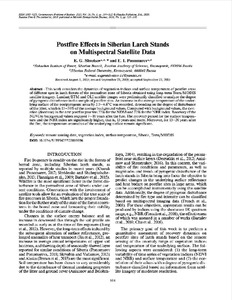Postfire Effects in Siberian Larch Stands on Multispectral Satellite Data
Скачать файл:
URI (для ссылок/цитирований):
https://link.springer.com/article/10.1134/S1995425520010096https://elib.sfu-kras.ru/handle/2311/143330
Автор:
Швецов, Евгений Геннадьевич
Пономарев, Евгений Иванович
Коллективный автор:
Институт экологии и географии
Кафедра экологии и природопользования
Дата:
2020-01Журнал:
Contemporary Problems of EcologyКвартиль журнала в Scopus:
Q3Квартиль журнала в Web of Science:
Q4Библиографическое описание:
Швецов, Евгений Геннадьевич. Postfire Effects in Siberian Larch Stands on Multispectral Satellite Data [Текст] / Евгений Геннадьевич Швецов, Евгений Иванович Пономарев // Contemporary Problems of Ecology. — 2020. — Т. 13 (№ 1). — С. 104-112Аннотация:
This work considers the dynamics of vegetation indices and surface temperature of postfire areas of different ages in larch forests of the permafrost zone of Siberia obtained using long-term Terra/MODIS satellite imagery. Landsat/ETM and OLI satellite images were preliminarily classified to analyze the degree of pyrogenic disturbance in the sample of postfire sites. An increase in the average temperature of the underlying surface of the postpyrogenic areas by 3.9–4.6°C was recorded, depending on the degree of disturbance of the litter, which is 15–30% of the average background values. Compared with background values, the deviation (decrease) in the next postfire year was 22% for the NDVI and 72% for the NBR index. Recovery of the NDVI to background values required 7–10 years after the fire. The recovery period for the surface temperature and the NBR index are significantly higher, that is, 15 years and more. Moreover, for 15–20 years after the fire, the temperature anomalies of the underlying surface remain significant.

